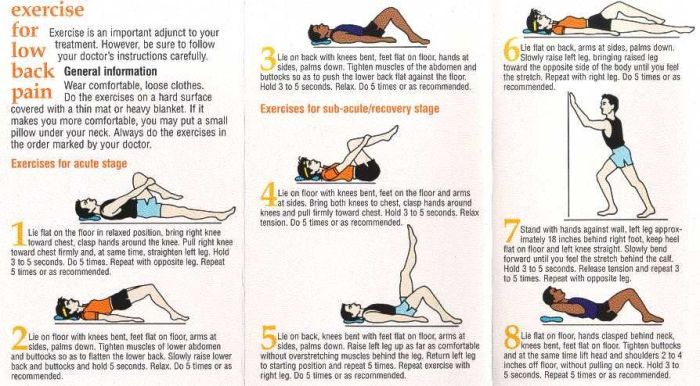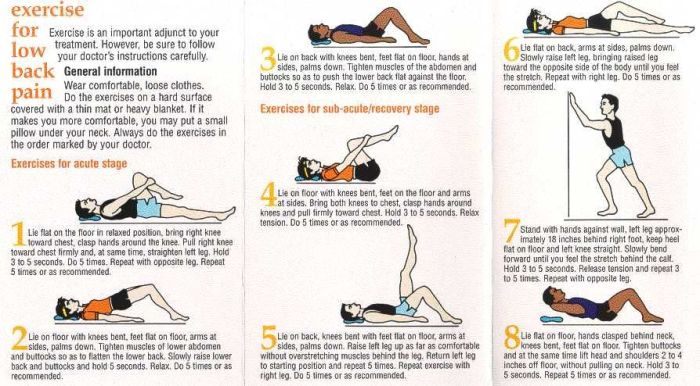Physical therapy and exercises for low back pain offer a powerful approach to managing and alleviating discomfort. This guide delves into the various types of exercises, tailored programs, and crucial lifestyle considerations to effectively address low back pain. We’ll explore everything from understanding the different types of back pain to creating a personalized home exercise routine and integrating healthy lifestyle habits.
Low back pain affects millions, and the right approach can make a significant difference. This comprehensive guide will cover everything from basic exercises to advanced techniques, empowering you to take control of your back health.
Introduction to Low Back Pain
Low back pain (LBP) is a common ailment affecting people of all ages and backgrounds. It’s a significant global health concern, impacting daily activities and quality of life. The prevalence of LBP varies, but studies consistently show it affects a substantial portion of the population, often recurring or becoming chronic.Understanding the causes of LBP is crucial for effective management.
Factors ranging from poor posture and muscle imbalances to underlying conditions like arthritis and herniated discs contribute to the pain experience. Often, the exact cause remains elusive, highlighting the complexity of the issue.
Prevalence and Impact of Low Back Pain
Low back pain is a leading cause of disability worldwide. Millions experience it annually, impacting productivity, personal relationships, and overall well-being. The pain can vary in intensity and duration, influencing the individual’s ability to perform routine tasks and participate in social activities.
Importance of Physical Therapy for LBP
Physical therapy plays a vital role in managing low back pain. It focuses on restoring function, reducing pain, and improving overall well-being. Physical therapists use a variety of techniques, including manual therapy, exercise prescription, and patient education, to help individuals regain strength, flexibility, and mobility.
Role of Exercises in Alleviating Low Back Pain
Specific exercises tailored to individual needs can significantly reduce low back pain symptoms. These exercises often target core strength, flexibility, and posture. Progressive exercises, gradually increasing intensity and complexity, help build resilience and prevent future episodes. Proper form and technique are critical to avoid exacerbating the pain.
Types of Low Back Pain
Different types of low back pain require tailored approaches to treatment. Understanding the nuances of acute, chronic, and herniated disc pain is essential for appropriate management.
| Type of Low Back Pain | Description | Common Causes | Typical Duration |
|---|---|---|---|
| Acute Low Back Pain | Sudden onset of pain, typically lasting less than 6 weeks. | Strains, sprains, poor lifting techniques. | Usually resolves within a few weeks with conservative treatment. |
| Chronic Low Back Pain | Persistent pain lasting longer than 3 months. | Underlying conditions, degenerative changes, psychological factors. | May require ongoing management and rehabilitation. |
| Herniated Disc | A rupture or protrusion of the intervertebral disc, often causing nerve impingement. | Lifting heavy objects, sudden twisting movements, degeneration. | May vary depending on severity, requiring different treatment approaches. |
Types of Physical Therapy Exercises
Effective physical therapy for low back pain often involves a multifaceted approach, tailoring exercises to address specific needs and limitations. Understanding the different types of exercises and their proper execution is crucial for achieving optimal results and preventing further injury. This section will delve into the common exercises used in physical therapy, categorized by their function, along with proper form and technique, and different approaches to exercise programs.
Common Exercise Categories
Physical therapy for low back pain typically utilizes exercises targeting different aspects of the back and core. These exercises can be broadly classified into strengthening, stretching, and stabilization exercises.
Strengthening Exercises
Strengthening exercises are designed to build muscle strength in the core and surrounding back muscles, which helps support the spine and reduce the risk of future pain. Examples include abdominal exercises, back extensions, and glute bridges.
| Exercise | Proper Form and Technique | Image Description |
|---|---|---|
| Glute Bridges | Lie on your back with knees bent and feet flat on the floor. Engage your glutes and lift your hips off the ground, squeezing your glutes at the top of the movement. Lower your hips slowly and controlled, maintaining a neutral spine. | A person lying supine with knees bent and feet flat on the floor. Their hips are raised off the ground, forming a straight line from knees to shoulders. Their core is engaged, and their glutes are squeezed at the top of the movement. |
| Plank | Start on your forearms and toes, keeping your body in a straight line from head to heels. Engage your core and glutes to maintain stability. Hold the position for a set duration, breathing steadily. | A person positioned on their forearms and toes, forming a straight line from head to heels. Their core is engaged, and their body is held in a stable plank position. |
| Bird Dog | Start on all fours. Extend one arm forward and the opposite leg backward, keeping your back straight and core engaged. Maintain the position for a moment, then return to the starting position. Alternate sides. | A person on all fours, with one arm extended forward and the opposite leg extended backward. Their back is straight, and their core is engaged, maintaining a stable posture. |
Stretching Exercises
Stretching exercises help improve flexibility and range of motion in the back and surrounding muscles, reducing stiffness and improving posture. Examples include hamstring stretches, piriformis stretches, and spinal twists.
| Exercise | Proper Form and Technique | Image Description |
|---|---|---|
| Hamstring Stretch | Sit on the floor with one leg extended straight out in front of you. Gently lean forward from your hips, reaching towards your toes. Keep your back straight and avoid rounding your spine. Hold for a count. | A person sitting on the floor, with one leg extended straight out. They are leaning forward from their hips, reaching towards their toes. Their back is straight, and their core is engaged. |
| Piriformis Stretch | Lie on your back with one leg bent and the other leg crossed over the bent knee. Gently pull the bent knee towards your chest, feeling the stretch in your buttock. Hold for a count. | A person lying supine with one leg bent and the other leg crossed over the bent knee. They are gently pulling the bent knee towards their chest. |
Stabilization Exercises
Stabilization exercises focus on strengthening the muscles that support the spine, improving stability and reducing pain. These exercises often involve slow, controlled movements, emphasizing proper posture and core engagement. Examples include pelvic tilts, side bridges, and bird dog exercises.
Exercise Program Approaches
Different approaches exist for structuring exercise programs for low back pain. Progressive overload is a common method, gradually increasing the intensity, duration, or repetitions of exercises over time.
Core Strength Exercises
Core strength is essential for spinal stability and support. Exercises like planks, bird dogs, and crunches are effective for strengthening the core muscles.
Spinal Mobility Exercises
Exercises that improve spinal mobility include gentle spinal twists, cat-cow stretches, and back extensions. These help maintain flexibility and range of motion in the spine.
Warm-up and Cool-down Routines
A proper warm-up prepares the muscles for exercise, reducing the risk of injury. A cool-down helps the body recover after exercise, reducing muscle soreness and promoting recovery. Warm-ups should involve light cardio and dynamic stretches, while cool-downs should include static stretches held for a specific duration.
Specific Exercise Recommendations
Finding the right exercises for your low back pain is crucial for effective management. A personalized approach, tailored to the specific cause and severity of your pain, is key to achieving lasting relief and preventing future issues. These exercises, when performed correctly and consistently, can strengthen supporting muscles, improve posture, and reduce stress on the spine. Remember, always consult your physical therapist before starting any new exercise program.Effective exercise programs for low back pain often involve a combination of stretching, strengthening, and stabilization exercises.
The goal is to restore proper muscle function, alleviate pain, and improve overall spinal health. This section provides detailed explanations of exercises targeting common low back pain issues, highlighting the muscles engaged and the benefits.
Strengthening Exercises for Muscle Imbalances
Addressing muscle imbalances is vital for low back health. Weak abdominal muscles, for instance, can contribute to poor posture and increased strain on the lumbar spine. Strengthening these muscles helps create a more stable core, reducing the risk of injury.
- Plank: This exercise targets the core muscles, including the rectus abdominis, transverse abdominis, and erector spinae. Maintaining a straight line from head to heels, engage your core to stabilize your body. Hold for 15-30 seconds, gradually increasing the duration as strength improves. Benefits include improved core strength and spinal stabilization.
- Bird Dog: This exercise works the erector spinae muscles and deep core stabilizers. Start on your hands and knees, extend one arm forward and the opposite leg backward, keeping your back straight. Hold for a few seconds before returning to the starting position. This exercise helps improve spinal mobility and stability.
- Glute Bridges: Focuses on strengthening the gluteal muscles, which are essential for maintaining proper posture and spinal support. Lie on your back with knees bent and feet flat on the floor. Lift your hips off the floor, squeezing your glutes at the top. Hold for a few seconds before slowly lowering your hips back down. Improves hip extension and core strength.
Postural Exercises for Improved Alignment
Poor posture can significantly impact low back health, leading to pain and discomfort. Exercises that promote good posture can help alleviate strain on the spine and surrounding tissues.
- Wall Sits: Stand with your back against a wall, keeping your knees at a 90-degree angle. Hold this position for 30-60 seconds, focusing on maintaining good posture. This exercise helps strengthen postural muscles and improve spinal alignment.
- Chin Tucks: Sit or stand tall, gently pull your chin back towards your chest. Hold for a few seconds, focusing on maintaining a straight neck and upper back. This exercise helps correct forward head posture, reducing stress on the neck and upper back, which can indirectly affect the low back.
Exercises for Disc Injuries
Exercises for disc injuries focus on gentle movements to reduce pain and inflammation. Always consult your physician or physical therapist before starting any exercises for disc injuries.
- Gentle Spinal Stretches: These stretches should be performed slowly and gently, focusing on maintaining a neutral spine. Examples include cat-cow stretches, knee-to-chest stretches, and gentle side bends. These exercises improve spinal mobility and reduce stiffness.
- Pelvic Tilts: Lie on your back with knees bent and feet flat on the floor. Engage your core and gently tilt your pelvis upward, arching your lower back slightly. Hold for a few seconds, then return to the starting position. This exercise helps strengthen the core muscles and improve spinal posture.
Personalized Exercise Programs
A personalized exercise program is essential for effective low back pain management. The program should be tailored to the individual’s specific needs, considering factors like pain level, muscle imbalances, and medical history.
- Patient-Specific Factors: Consider the patient’s medical history, pain level, and overall fitness level when designing the program. Factors like age, occupation, and daily activities should also be considered.
- Gradual Progression: Start with low-intensity exercises and gradually increase the intensity and duration as tolerated. Listening to your body and modifying exercises as needed is crucial.
- Proper Form: Correct form is paramount. If you’re unsure about proper form, seek guidance from a physical therapist.
Exercise Progression and Safety: Physical Therapy And Exercises For Low Back Pain

Taking a cautious and gradual approach to exercise is crucial for managing low back pain and preventing setbacks. A well-structured progression plan ensures that your body adapts safely and effectively to the demands of the exercises, minimizing the risk of injury and maximizing your recovery. This section will guide you through the principles of exercise progression, emphasizing proper form and technique, common mistakes to avoid, modifications for various physical limitations, and crucial safety precautions.
Gradual Progression of Intensity and Duration
Effective exercise programs for low back pain involve a phased approach. Starting with low-intensity exercises for shorter durations allows your body to adjust and strengthens supporting muscles before increasing the challenge. Gradually increasing the intensity and duration over time is key to achieving optimal results while preventing pain or exacerbations. This approach respects the individual’s recovery process and limits the risk of overexertion.
A good example is starting with 5 repetitions of a simple back extension exercise for 10 minutes, then gradually increasing the repetitions to 10, the duration to 15 minutes, and eventually the sets to 3.
Importance of Proper Form and Technique
Maintaining proper form and technique throughout your exercises is paramount for preventing injuries and maximizing the effectiveness of your workouts. Incorrect form can place undue stress on your back, potentially worsening pain or leading to new injuries. Focus on maintaining a neutral spine throughout each movement and using controlled, slow, and deliberate motions. Seek professional guidance for personalized instructions on proper technique.
Common Mistakes to Avoid and Strategies to Prevent Re-injury
Common mistakes include rushing through exercises, using excessive force, or neglecting proper warm-up and cool-down routines. Avoid pushing yourself beyond your pain tolerance and listen to your body. If you experience sharp pain, stop the exercise immediately. A crucial strategy is to incorporate regular warm-up activities before each session to prepare the muscles and increase blood flow.
Also, a cool-down period helps the muscles recover and reduces the risk of stiffness or soreness.
Modifications for Different Physical Limitations
Exercise modifications are essential to accommodate various physical limitations, ensuring that individuals with different abilities can safely and effectively participate in exercise programs. These modifications may involve adjusting the intensity, duration, or type of exercise, using assistive devices, or modifying the exercise’s range of motion. For instance, if you have limited mobility, you might need to modify the exercise’s range of motion or use a chair to support your body.
A physical therapist can provide personalized modifications based on individual needs and limitations.
Safety Precautions During Exercises for Low Back Pain
Prioritize safety during your exercises by ensuring a supportive and comfortable environment. Consider the surface on which you are exercising, ensuring it is stable and non-slippery. Always have someone present to assist you if needed. Keep your surroundings clear of obstructions to prevent falls. If you have any underlying health conditions or are taking medications, consult your doctor or physical therapist before starting any new exercise program.
Use proper body mechanics, such as bending your knees and keeping your back straight when lifting objects.
Home Exercise Program

Taking control of your low back pain often involves a multifaceted approach, and a crucial component is a well-structured home exercise program. This program, when combined with other strategies, can significantly improve your pain management and recovery. It’s important to remember that this is a sample program, and you should always consult with a physical therapist before starting any new exercise routine.
Physical therapy and targeted exercises are crucial for managing low back pain, helping to strengthen core muscles and improve posture. However, understanding the impact of other health conditions, like diabetes, is also important. For instance, how does diabetes affect a person’s ability to engage in physical therapy and exercises for low back pain? This is a complex question and understanding if diabetes is considered a disability is vital in tailoring a patient’s care plan.
Is diabetes a disability ? Ultimately, the best approach to low back pain, especially for those with diabetes, often involves a multidisciplinary team approach that considers both the physical therapy and the specific needs of the individual.
Modifying exercises based on your individual needs and limitations is vital.Consistency and adherence to your home exercise program are key to achieving positive results. The more diligently you follow the prescribed exercises, the more effectively your body will adapt and strengthen, leading to reduced pain and improved function.
Sample Home Exercise Program
This sample program Artikels exercises for managing low back pain, emphasizing proper form and safety. Remember to listen to your body and stop if you experience any pain. Always consult with your physical therapist before beginning any new exercise program.
- Cat-Cow Stretch (5 repetitions, 2-3 times per day): Start on your hands and knees. Inhale and arch your back like a cow, dropping your belly towards the floor. Exhale and round your back like a cat, tucking your chin towards your chest. This exercise helps mobilize the spine and improve flexibility.
- Knee-to-Chest Stretch (5 repetitions, 2-3 times per day): Lie on your back and gently pull one knee towards your chest. Hold for 15-30 seconds, and repeat on the other side. This stretch targets the lower back muscles, promoting relaxation and relieving tension.
- Bird-Dog Exercise (5 repetitions per side, 2-3 times per day): Start on your hands and knees. Extend one arm forward and the opposite leg back, keeping your back straight. Hold for a few seconds, then return to the starting position and repeat on the other side. This exercise strengthens the core muscles, which support the spine.
- Pelvic Tilts (10-15 repetitions, 2-3 times per day): Lie on your back with knees bent. Tighten your abdominal muscles and gently press your lower back into the floor. Hold for a few seconds, then relax. This exercise helps strengthen the muscles that support the lower back.
- Wall Slides (10-15 repetitions, 2-3 times per day): Stand facing a wall, about a foot away. Place your hands on the wall at shoulder height. Keeping your back straight, slide your back down the wall until your knees are bent at a 90-degree angle. Slowly slide back up to the starting position. This exercise strengthens the back muscles and improves posture.
Importance of Consistency and Adherence
Adherence to the exercise program is critical for achieving positive outcomes. Consistency in performing the exercises as prescribed strengthens the muscles supporting the spine, improves flexibility, and promotes healing. Studies show that individuals who consistently follow their prescribed exercises experience significantly reduced pain and improved functional capacity.
Monitoring Progress and Adjusting the Program, Physical therapy and exercises for low back pain
Regularly tracking your progress is essential to adapt your home exercise program as needed. Maintain a log to note any changes in pain levels, range of motion, and overall function. If you experience increased pain or discomfort during exercises, reduce the repetitions or modify the exercises. If you notice no improvement after a few weeks, consult with your physical therapist to evaluate your program and make necessary adjustments.
Physical therapy and exercises are crucial for managing low back pain, focusing on strengthening core muscles and improving flexibility. However, sometimes underlying respiratory issues can impact recovery, such as those reflected in the FEV1/FVC ratio, a key measurement in spirometry tests like the FEV1/FVC ratio of FEV1 to FVC spirometry. Understanding this ratio can help therapists tailor exercises to support overall lung function, ultimately aiding the healing process of low back pain.
A physical therapist can assess your progress, provide feedback, and tailor the exercises to your specific needs.
Resources for Home Exercise Programs
Several resources can provide additional home exercise programs and support.
- Websites: Look for websites dedicated to back pain exercises, physical therapy, or rehabilitation. Search for reputable sites like the National Institutes of Health (NIH) or Mayo Clinic.
- Apps: Numerous apps offer guided exercise programs for various conditions, including low back pain. Research user reviews and consider those with positive feedback and professional guidance.
- Physical Therapy Clinics: Many physical therapy clinics provide educational materials and exercise videos on their websites or social media platforms.
Seeking Professional Guidance
Creating and adapting a home exercise program for low back pain requires professional guidance. A physical therapist can assess your specific condition, develop a personalized program, and provide crucial feedback and support. They can ensure you’re performing exercises correctly to avoid further injury and maximize effectiveness. A personalized program ensures the exercises are safe and effective for your specific needs.
Physical therapy and targeted exercises can really help alleviate low back pain, but sometimes, underlying issues can complicate things. For instance, have you ever wondered why you’re always ravenous? Digging deeper into the root causes of constant hunger might reveal connections to your back pain. Understanding these potential links could lead to more effective treatments for both, and further research into this can be found on why am i always hungry.
Ultimately, a comprehensive approach to physical therapy and exercises, combined with a thorough understanding of your overall health, is key to managing low back pain effectively.
Integrating Lifestyle Factors
Beyond targeted exercises, managing low back pain effectively hinges on holistic lifestyle adjustments. These modifications complement physical therapy, fostering long-term pain relief and preventing future episodes. A proactive approach addressing posture, ergonomics, and sleep patterns significantly enhances the effectiveness of your treatment plan. By incorporating these lifestyle changes, you can actively participate in your recovery and maintain a healthier spine for years to come.Lifestyle modifications play a crucial role in the long-term management of low back pain.
They act as a crucial support system to physical therapy, empowering you to take charge of your well-being and actively participate in your recovery. This includes understanding the interplay between posture, ergonomics, and sleep habits and actively working to optimize them.
Posture
Maintaining proper posture throughout the day is vital for spinal health. Poor posture puts undue stress on the spine, exacerbating existing pain and potentially leading to further problems. It’s not just about standing tall; it encompasses all daily activities, from sitting at your desk to lifting objects. Correct posture involves aligning the head, shoulders, hips, and knees to minimize strain on the spinal column.
Ergonomics
Ergonomics refers to designing the workplace and daily activities to fit the human body. Proper ergonomic principles can prevent discomfort and injury, especially in jobs requiring prolonged sitting or repetitive movements. Adjusting your workspace to accommodate your body’s needs is crucial for minimizing strain on your back. This includes selecting a chair with adequate lumbar support, ensuring your monitor is at eye level, and taking regular breaks to stretch and move around.
Sleep Habits
Adequate sleep is essential for the body’s healing processes. A comfortable mattress and pillow that support the natural curvature of your spine are paramount. Sleeping in a position that minimizes strain on your back, such as on your side with a pillow between your knees, is crucial. Avoiding prolonged periods in awkward positions while sleeping can significantly contribute to minimizing back pain.
Practical Advice for Improving Posture and Ergonomics
- Sit upright with your back supported. Use a chair with good lumbar support, and avoid slouching. Regularly adjust your posture throughout the day to prevent stiffness.
- Maintain good posture while standing. Keep your shoulders back and relaxed, and engage your core muscles. Imagine a string pulling you up from the crown of your head.
- Lift objects properly. Bend your knees, keep your back straight, and lift with your legs, not your back. Avoid twisting while lifting.
- Organize your workspace. Keep frequently used items within easy reach to minimize bending and twisting.
- Take regular breaks. Get up and move around every 30-60 minutes, even if it’s just for a few minutes.
Lifestyle Factors Contributing to Low Back Pain and Strategies to Address Them
| Lifestyle Factor | Strategies to Address |
|---|---|
| Poor Posture | Regular posture checks, ergonomic adjustments, and exercises to strengthen core muscles. |
| Sedentary Lifestyle | Incorporate regular physical activity, aim for at least 150 minutes of moderate-intensity aerobic activity per week. |
| Inadequate Sleep | Establish a regular sleep schedule, create a relaxing bedtime routine, and ensure a supportive sleep environment. |
| Heavy Lifting/Improper Lifting Techniques | Proper lifting techniques, use of lifting aids if needed, and strength training to improve back and core muscles. |
| Stress | Stress management techniques such as meditation, yoga, or spending time in nature. |
| Poor Diet | Consume a balanced diet rich in fruits, vegetables, and whole grains. |
| Obesity | Maintain a healthy weight through a balanced diet and regular exercise. |
Creating a Holistic Approach to Low Back Pain Management
A holistic approach to managing low back pain recognizes the interconnectedness of physical, emotional, and environmental factors. It emphasizes not only the physical aspects of the condition but also the importance of mental well-being, sleep quality, and overall lifestyle choices. This integrated strategy fosters long-term pain relief and empowers you to take control of your health journey.
Addressing Common Pain Triggers
Low back pain is often more than just a physical ailment; it can significantly impact your overall well-being, affecting your mood, sleep, and daily activities. Understanding the potential triggers beyond the physical mechanics of the back is crucial for effective management. Identifying and addressing these factors can lead to a more comprehensive and lasting solution.Effective pain management requires a holistic approach, recognizing that physical factors are intertwined with psychological and lifestyle elements.
Addressing the underlying causes, such as stress, poor sleep, and improper lifting techniques, is just as important as targeted exercises and therapies. By understanding and managing these triggers, you can significantly improve your ability to cope with and overcome low back pain.
Stress and its Impact on Low Back Pain
Stress, whether stemming from work, relationships, or personal challenges, can significantly exacerbate low back pain. Chronic stress releases hormones that can lead to muscle tension, inflammation, and reduced pain tolerance. Stress can also disrupt sleep patterns, further contributing to pain and discomfort. Recognizing the connection between stress and pain is a critical step toward effective management.
Poor Sleep and Low Back Pain
Adequate sleep is essential for muscle recovery and overall health, including back health. Poor sleep quality or quantity can contribute to muscle stiffness, tension, and pain. This is because insufficient sleep disrupts the body’s natural healing processes. Establishing a consistent sleep schedule and creating a relaxing bedtime routine can significantly improve sleep quality and reduce low back pain.
Improper Lifting Techniques
Incorrect lifting techniques are a frequent culprit in low back pain. Poor posture, improper lifting mechanics, and inadequate warm-up routines can strain the back muscles and lead to injury. Learning and practicing proper lifting techniques is crucial to prevent future episodes of low back pain. This includes maintaining a neutral spine, using your leg muscles, and keeping the load close to your body.
Psychological Impact of Low Back Pain
Low back pain can have a profound psychological impact on individuals. The pain can lead to anxiety, depression, and feelings of helplessness. It can also affect self-esteem and reduce the ability to participate in daily activities. It is essential to address the psychological impact alongside the physical aspects of the pain to achieve optimal recovery. Addressing these concerns through therapy or support groups can be highly beneficial.
Stress Management Techniques
Various stress management techniques can help mitigate the impact of stress on low back pain. These include mindfulness practices like meditation, deep breathing exercises, progressive muscle relaxation, and yoga. Consistent practice of these techniques can reduce muscle tension, improve sleep, and enhance overall well-being. Creating a supportive social network and engaging in activities you enjoy can also play a significant role in stress management.
Resources for Further Exploration
- Books: “The Back Pain Solution” by Stuart McGill, “Your Back: The Ultimate Guide to Understanding and Treating Back Pain” by Dr. David H. G. These books provide comprehensive information on the causes and management of low back pain, often emphasizing preventative measures and lifestyle changes.
- Articles: Numerous articles from reputable medical journals and online health resources can offer valuable insights into the different aspects of low back pain triggers. Search for articles related to stress management and low back pain, or specific lifting techniques.
- Support Groups: Connecting with others experiencing similar challenges through support groups can provide valuable emotional support and practical advice. Online forums and in-person groups can be beneficial.
Measuring Outcomes and Monitoring Progress
Tracking your progress is crucial in physical therapy for low back pain. Regular monitoring allows you and your therapist to see what’s working, identify areas needing adjustment, and ensure the plan is effective in achieving your goals. This helps you stay motivated and ensures you’re on the right path to recovery.
Importance of Monitoring Progress
Monitoring progress during physical therapy is essential for optimizing treatment effectiveness and ensuring patient satisfaction. Regular assessment allows for timely adjustments to the exercise program, providing personalized care tailored to individual needs and responses. It also helps build trust and a strong therapeutic relationship by demonstrating the therapist’s commitment to the patient’s well-being. Consistent monitoring facilitates a more accurate evaluation of the therapy’s impact and helps patients feel empowered in their recovery journey.
Metrics for Tracking Progress
Several metrics can be used to track progress, providing a comprehensive picture of the patient’s response to therapy. These metrics help quantify the impact of exercises and interventions.
- Pain Level: Use a standardized pain scale, such as the 0-10 Numeric Rating Scale (NRS), to assess pain intensity before, during, and after each session. This helps quantify pain reduction and provides objective data on the therapy’s effect.
- Range of Motion (ROM): Regularly measure the range of motion in the affected area using a goniometer or other appropriate measuring tools. Tracking changes in ROM helps demonstrate the therapy’s effect on joint mobility. This provides a tangible metric to evaluate progress.
- Functional Abilities: Assess functional abilities through specific tasks, like lifting, bending, or walking. Use a functional outcome scale (e.g., Roland-Morris Disability Questionnaire) to quantify how well the patient can perform daily activities. This evaluation reflects the impact of the therapy on everyday life.
Assessing Exercise Effectiveness
Evaluating the effectiveness of exercises and adjustments to the program is crucial for optimizing the therapy. This involves a careful analysis of the patient’s response to different exercises and the adjustments made to the program.
- Exercise Performance: Observe and record the patient’s ability to perform each exercise correctly, including form and intensity. This can help pinpoint areas where modifications are needed or if the exercise needs to be adjusted.
- Patient Feedback: Encourage the patient to provide feedback on the exercises and their perceived effectiveness. This subjective information can provide insights into any discomfort or challenges encountered during the therapy sessions.
- Modifications: Document any modifications made to the exercise program based on the patient’s feedback or progress. This ensures that the exercises remain challenging but manageable and appropriate to the individual’s current abilities.
Measuring Long-Term Outcomes
Long-term outcomes are essential for evaluating the lasting impact of the therapy. These measures extend beyond the initial stages of treatment and assess the therapy’s ability to prevent future episodes of low back pain.
- Frequency of Pain Episodes: Track the frequency and severity of pain episodes after the completion of the therapy program. This helps determine if the therapy has reduced the likelihood of future episodes.
- Return to Activities: Assess the patient’s ability to return to pre-injury activities and maintain that level of function. This provides a measure of the therapy’s effectiveness in restoring normal activities.
- Lifestyle Adjustments: Assess any lifestyle changes the patient has implemented to maintain their improved function. This shows the patient’s commitment to long-term well-being.
Progress Tracking Table
This table provides a template for tracking progress over time, including key metrics like pain levels, range of motion, and functional abilities.
| Date | Pain Level (NRS) | Range of Motion (degrees) | Functional Ability Score | Comments/Observations |
|---|---|---|---|---|
| [Date] | [Value] | [Value] | [Value] | [Description] |
| [Date] | [Value] | [Value] | [Value] | [Description] |
Ultimate Conclusion
In conclusion, managing low back pain effectively requires a multifaceted approach that combines targeted exercises, personalized programs, and mindful lifestyle choices. By understanding the different types of pain, practicing proper form, and adhering to a consistent routine, you can significantly reduce pain and improve your overall well-being. Remember, consistency and patience are key to achieving lasting results. This guide is meant to be a starting point; consulting with a healthcare professional is always recommended for personalized advice.




